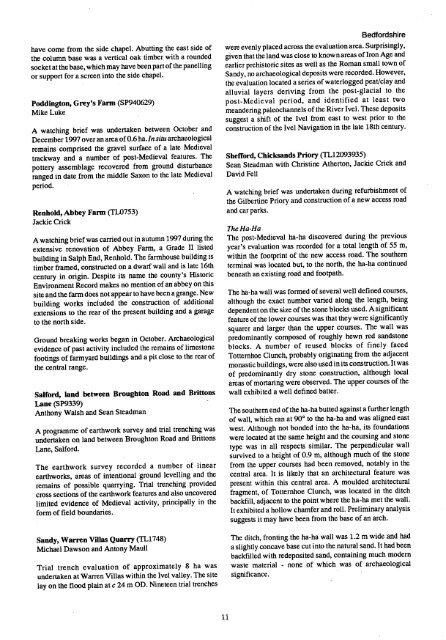CBA SMA\SMA 1998.PDF - Council for British Archaeology
CBA SMA\SMA 1998.PDF - Council for British Archaeology
CBA SMA\SMA 1998.PDF - Council for British Archaeology
You also want an ePaper? Increase the reach of your titles
YUMPU automatically turns print PDFs into web optimized ePapers that Google loves.
have come from the side chapel. Abutting the east side of<br />
the column base was a vertical oak timber with a rounded<br />
socket at the base, which may have been part of the panelling<br />
or support <strong>for</strong> a screen into the side chapel.<br />
Poddington, Grey's Farm (SP940629)<br />
Mike Luke<br />
A watching brief was undertaken between October and<br />
December 1997 over an area of 0.6 ha. In situ archaeological<br />
remains comprised the gravel surface of a late Medieval<br />
trackway and a number of post-Medieval features. The<br />
pottery assemblage recovered from ground disturbance<br />
ranged in date from the middle Saxon to the late Medieval<br />
period.<br />
Renhold, Abbey Farm (TL0753)<br />
Jaclde Crick<br />
A watching brief was carried out in autumn 1997 during the<br />
extensive renovation of Abbey Farm, a Grade II listed<br />
building in Salph End, Renhold. The farmhouse building is<br />
timber framed, constructed on a dwarf wall and is late 16th<br />
century in origin. Despite its name the county's Historic<br />
Environment Record makes no mention of an abbey on this<br />
site and the farm does not appear to have been a grange. New<br />
building works included the construction of additional<br />
extensions to the rear of the present building and a garage<br />
to the north side.<br />
Ground breaking works began in October. Archaeological<br />
evidence of past activity included the remains of limestone<br />
footings of farmyard buildings and a pit close to the rear of<br />
the central range.<br />
Sal<strong>for</strong>d, land between Broughton Road and Brittons<br />
Lane (SP9339)<br />
Anthony Walsh and Sean Steadman<br />
A programme of earthwork survey and trial trenching was<br />
undertaken on land between Broughton Road and Brittons<br />
Lane, Sal<strong>for</strong>d.<br />
The earthwork survey recorded a number of linear<br />
earthworlcs, areas of intentional ground levelling and the<br />
remains of possible quarrying. Trial trenching provided<br />
cross sections of the earthwork features and also uncovered<br />
limited evidence of Medieval activity, principally in the<br />
<strong>for</strong>m of field boundaries.<br />
Sandy, Warren Villas Quarry (TL1748)<br />
Michael Dawson and Antony Maull<br />
Trial trench evaluation of approximately 8 ha was<br />
undertaken at Warren Villas within the Ivel valley. The site<br />
lay on the flood plain at c 24 m OD. Nineteen trial trenches<br />
Bed<strong>for</strong>dshire<br />
were evenly placed across the evaluation area. Suiprisingly,<br />
given that the land was close to known areas of Iron Age and<br />
earlier prehistoric sites as well as the Roman small town of<br />
Sandy, no archaeological deposits were recorded. However,<br />
the evaluation located a series of waterlogged peat/clay and<br />
alluvial layers deriving from the post-glacial to the<br />
post-Medieval period, and identified at least two<br />
meandering paleochannels of the River Ivel. These deposits<br />
suggest a shift of the Ivel from east to west prior to the<br />
construction of the Ivel Navigation in the late 18th century.<br />
Shef<strong>for</strong>d, Chicicsands Priory (TL12093935)<br />
Sean Steadman with Christine Atherton, Jaclde Crick and<br />
David Fell<br />
A watching brief was undertaken during refurbishment of<br />
the Gilbertine Priory and construction of a new access road<br />
and car parks.<br />
The Ha-Ha<br />
The post-Medieval ha-ha discovered during the previous<br />
year's evaluation was recorded <strong>for</strong> a total length of 55 m,<br />
within the footprint of the new access road. The southern<br />
terminal was located but, to the north, the ha-ha continued<br />
beneath an existing road and footpath.<br />
The ha-ha wall was <strong>for</strong>med of several well defined courses,<br />
although the exact number varied along the length, being<br />
dependent on the size of the stone blocks used. A significant<br />
feature of the lower courses was that they were significantly<br />
squarer and larger than the upper courses. The wall was<br />
predominantly composed of roughly hewn red sandstone<br />
blocks. A number of reused blocks of finely faced<br />
Totternhoe Clunch, probably originating from the adjacent<br />
monastic buildings, were also used in its construction. It was<br />
of predominantly dry stone construction, although local<br />
areas of mortaring were observed. The upper courses of the<br />
wall exhibited a well defined batter.<br />
The southern end of the ha-ha butted against a further length<br />
of wall, which ran at 90° to the ha-ha and was aligned east<br />
west. Although not bonded into the ha-ha, its foundations<br />
were located at the same height and the coursing and stone<br />
type was in all respects similar. The perpendicular wall<br />
survived to a height of 0.9 m, although much of the stone<br />
from the upper courses had been removed, notably in the<br />
central area. It is likely that an architectural feature was<br />
present within this central area. A moulded architectural<br />
fragment, of Totternhoe Clunch, was located in the ditch<br />
backfill, adjacent to the point where the ha-ha met the wall.<br />
It exhibited a hollow chamfer and roll. Preliminary analysis<br />
suggests it may have been from the base of an arch.<br />
The ditch, fronting the ha-ha wall was 1.2 m wide and had<br />
a slightly concave base cut into the natural sand. It had been<br />
backfilled with redeposited sand, containing much modern<br />
waste material - none of which was of archaeological<br />
significance.<br />
11

















